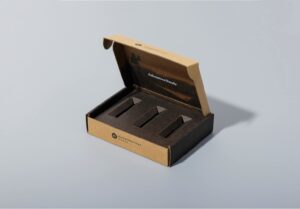Jako właściciel firmy e-commerce chcesz dostarczać swoje produkty bezpiecznie i stylowo, aby zdobyć lojalność klientów. Ale od czego zacząć w przypadku opakowań e-commerce? Ten kompleksowy przewodnik ma pomóc Ci poruszać się po podstawach i zawiłościach
opakowania e-commerce jako początkujący.
 1. Zrozumienie opakowań e-commerce
1. Zrozumienie opakowań e-commerce
Opakowanie e-commerce to proces i materiały wykorzystywane do przygotowywania produktów do wysyłki i dostawy online. Podczas gdy głównym celem jest ochrona produktu przed uszkodzeniem, dobre opakowanie może również poprawić wrażenia konsumenta z rozpakowywania, wzmocnić wizerunek marki i promować zrównoważony rozwój.
Opakowanie e-commerce zazwyczaj składa się z trzech głównych warstw: opakowania produktu lub opakowania podstawowego, opakowania wewnętrznego dla dodatkowej ochrony i opakowania zewnętrznego. To ostatnie jest tym, co Twój klient widzi jako pierwsze i z czym wchodzi w interakcję, a często jest to pierwszy fizyczny punkt styku Twojej marki z klientem. Dlatego też kluczowe jest, aby się liczyło!
3. Podstawy opakowań e-commerce
Opakowania w handlu internetowym spełniają trzy podstawowe cele: chronią produkt, kontrolują koszty wysyłki i budują tożsamość marki poprzez zapewnienie klientom wrażeń podczas rozpakowywania produktu.
Pierwsze wrażenia są najważniejsze i chociaż prawdą jest, że klienci najpierw widzą Twój produkt na ekranach komputerów, to pierwsza fizyczna interakcja jest tym, co liczy się dla utrzymania klienta. Doświadczenie rozpakowywania jest prawdziwym pierwszym wrażeniem Twojej marki.
Oczekiwania i oczekiwania Twoich klientów są zbudowane na prostym obrazie cyfrowym, ale Twoja firma jest odpowiedzialna za spełnianie lub przekraczanie oczekiwań klientów. Jak to osiągnąć?
Osiąga się to poprzez wybór opakowania na podstawie celu, a nie atrakcyjności. Innymi słowy, liczy się to, co jest w środku.
Odpowiedzialność za wewnętrzne opakowanie jest najważniejsza – powinno ono chronić Twój produkt podczas podróży do klienta. Należy wziąć pod uwagę kilka materiałów ochronnych, w tym folię bąbelkową, poduszki powietrzne, wkładki piankowe i biodegradowalne orzeszki do pakowania. Wybór wewnętrznego opakowania często zależy od rodzaju produktu.
Opakowanie zewnętrzne to pierwsze wrażenie Twojej marki, jakie klienci fizycznie odczują. Podczas gdy torby pocztowe mogą być opłacalnym i lekkim rozwiązaniem dla przedmiotów niedelikatnych, sztywne pudełka zapewniają większą ochronę delikatnym lub luksusowym produktom. Pamiętaj, że Twój wybór opakowania zewnętrznego powinien reprezentować Twoją markę, biorąc pod uwagę wymagania bezpieczeństwa Twojego produktu.
 6. Możliwości budowania marki dzięki opakowaniom e-commerce
6. Możliwości budowania marki dzięki opakowaniom e-commerce
Opakowania e-commerce oferują wiele możliwości brandingu. Dostosowanie opakowania do kolorów, logo i sloganów Twojej marki może stworzyć niezapomniane wrażenia z rozpakowywania dla Twoich klientów. Ponadto możesz dołączyć notatki z podziękowaniami, kody rabatowe na przyszłe zakupy, a nawet drobne gratisy, co jeszcze bardziej promuje lojalność wobec marki i zachęca do powtarzających się zakupów.
Ponieważ kwestie środowiskowe coraz bardziej wpływają na decyzje zakupowe konsumentów, rośnie trend w kierunku zrównoważonych opakowań. Biodegradowalne materiały opakowaniowe, minimalistyczne opakowania i zachęcanie do recyklingu lub ponownego wykorzystywania opakowań mogą poprawić ekologiczny wizerunek Twojej marki.
Inwestowanie w niestandardowe opakowania do handlu elektronicznego może zwiększyć rozpoznawalność marki i poprawić jakość obsługi klienta, co przekłada się na lojalność klientów i wzrost sprzedaży.
Weź pod uwagę rozmiar, kształt, wagę i kruchość swoich produktów. W razie potrzeby skonsultuj się z profesjonalistami od pakowania, aby upewnić się, że Twoje produkty są chronione podczas wysyłki.
3. Czy mogę uwzględnić kolory i logo mojej marki na opakowaniu?
Tak, i jest to wysoce zalecane. Opakowania firmowe pomagają zwiększyć świadomość marki i rozpoznawalność.
Przykładami są poddane recyklingowi tektury, biodegradowalne wypełniacze, takie jak wypełniacze z mąki kukurydzianej, oraz biodegradowalne torby pocztowe.
Efektywne projektowanie opakowań może ograniczyć wykorzystanie zbędnych materiałów, obniżając tym samym koszty pakowania.
Poruszanie się po krajobrazie opakowań e-commerce może wydawać się zniechęcające, ale gdy zrozumiesz podstawy, możliwości są ogromne. Strategiczny i dobrze zaplanowany system opakowań e-commerce może przekształcić zwykłą dostawę w inspirujące doświadczenie marki, jednocześnie podtrzymując zobowiązanie do bezpieczeństwa produktu i odpowiedzialności ekologicznej. Optymalizując i dostosowując proces pakowania, możesz stworzyć niezapomniane doświadczenie rozpakowywania i zwiększyć sukces swojej marki.
 1. Zrozumienie opakowań e-commerce
1. Zrozumienie opakowań e-commerce
 6. Możliwości budowania marki dzięki opakowaniom e-commerce
6. Możliwości budowania marki dzięki opakowaniom e-commerce